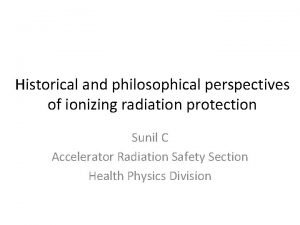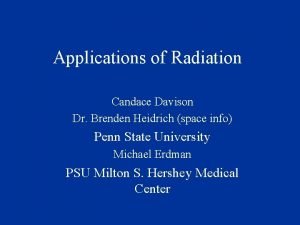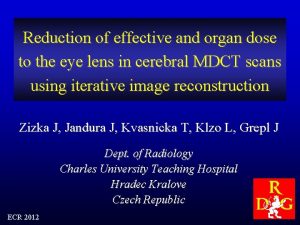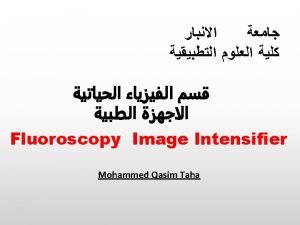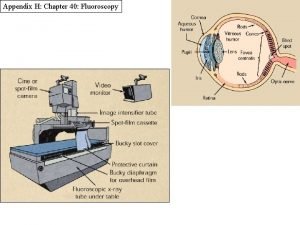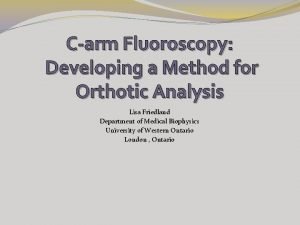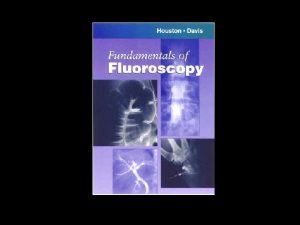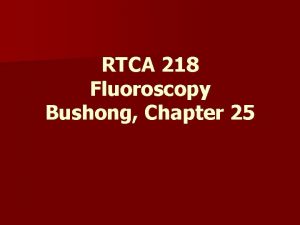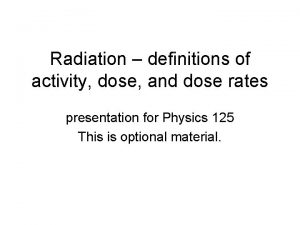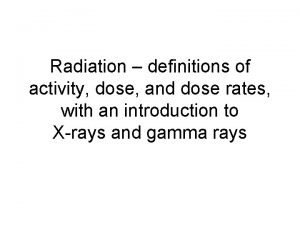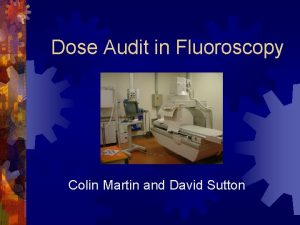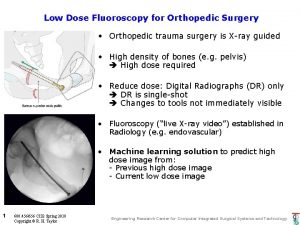Radiation dose assessment of routine fluoroscopy procedures in










- Slides: 10

Radiation dose assessment of routine fluoroscopy procedures in adult patients referred to Namazi Hospital in 2019 Fariba Zarei 1, 2, Sara Doosideh 1, 2, Rezvan Ravanfar Haghighi 1, * 1 Medical Imaging Research Center, Shiraz University of Medical Sciences, Shiraz, Iran 2 Radiology Department, Shiraz University of Medical Sciences , Shiraz, Iran

Introduction • In diagnostic radiography, the highest cumulative dose is attributed to fluoroscopic examinations. • There is no dose constraint for patient in diagnostic and therapeutic procedures. • Determination of the patient radiation dose by a simple method and its comparison to that of the national and international reference levels has an important role in dose optimization and patient radiation protection. • Still the patient radiation dose in routine fluoroscopic procedures has not been determined in hospitals affiliated to Shiraz University of Medical Sciences. • Therefore, the present study was performed to evaluate the radiation dose of routine fluoroscopic procedures in adult patients referred to Namazi Hospital during 2019.

Materials and Methods • In this cross sectional-retrospective study, cumulative dose area product (DAP) and duration of each routine fluoroscopy of 600 adult patients (≥ 18 years) referred to Namazi hospital were evaluated. • Routine fluoroscopic procedures included: barium swallow (BSW), barium enma (BEN), retrograde urethrogram (RUG), retrograde cystogram (RCG), histro-salpingogram (HSG), upper gastrointestinal series (UGI), voiding cystouretrography (VCUG), distal loopogram (DLG), Defeco • Demographic data such as patient's age, sex, height, weight were also recorded.

Materials and Methods • A remote controlled fluoroscopy unit equipped with digital detector used to preform routine fluoroscopy procedures • Transparent dose area product (DAP) meter, attached to the collimator of the fluoroscopy unit was used to measure entrance radiation dose to surface of the patient’s body. • It has to be noted that the fluoroscopic DAP meter’s performance is tested semi-annually using reference DAP meter, by an expert medical physicist.

Results • The mean age of patients was 48. 6± 15. 6 (18 -90) years, 36. 5% were male and 63. 5% were female. • The mean and standard deviation of Body Mass Index was 25± 5. • The highest and lowest frequency percentage were Barium-Swallow (BSW, 43. 7%) and retrogradecystogram (RCG, 1. 7%) with corresponding DAP of 10 and 18 Gy. cm 2.

Results • The mean time of fluoroscopy procedures were 2. 08± 1. 51 minutes. • The highest and lowest DAP values were from barium-enema (BEN) and histrosalpingogram (HSG) which were 36 and 6 Gy. cm 2 respectively. • There is a linear correlation between DAP and fluoroscopy time (r=0. 403) and BMI (r=0. 249) in both cases the observed correlation was statistically significant (p<0. 001). • There is a linear relationship between DAP and patient’s age (r=0. 075) but the observed correlation was not statistically significant (p=0. 066). • There is no correlation between patient dose and sex.

Results The differences of mean fluoroscopy time and DAP for different routine procedures were statistically meaningful (p<0. 001). Fluoroscopic procedure Time (in mean±SD BSW 2. 28± 1. 12 BEN minute) Time (in minute) median DAP (in Gy. cm 2) mean±SD DAP (in Gy. cm 2) Median 2. 1 9. 93± 9. 4 7. 54 3. 52± 1. 98 3. 4 35. 8± 32 29. 8 DEFECO 0. 98± 0. 69 0. 9 22. 7± 13 19. 8 UGI 3. 77± 1. 91 3. 2 24. 7± 16 24 RCG 2. 74± 2. 5 2. 0 18. 6± 15 19 RUG 1. 98± 1. 11 1. 6 13. 9± 12 10. 5 DLG 3. 29± 2. 08 2. 8 24. 7± 18 18 HSG 0. 88± 0. 83 0. 7 5. 9± 7 4 VCUG 2. 9± 1. 08 3 23. 4± 16. 7 18

Discussion • The most frequent fluoroscopy in the present study is BSW which can be attributed to the high prevalence of gastro-intestinal disease in Shiraz, in other researches BSW did not have the highest frequency 1, 2. • In the present study the highest mean time of fluoroscopy was for RCG (3. 77 mints) and then BEN (3. 52 mints) and minimum time was for HSG (0. 8) which are in line with Changizi 3 and Ridzwan 2. • The fluoroscopic time has to be reduced to keep radiation dose to the patient as low as reasonably achievable (with acceptable image quality of image)4.

Discussion • The mean of DAP has the highest value in BEN (35. 8 Gy. cm 2) and lowest value in HSG (5. 9 Gy. cm 2). These results are in line with Ridzwan 2 et al. • The higher radiation dose in BEN can be attributed to the higher fluoroscopy time. • The results of DAP measurement of the present study (29. 8, 4 and 7. 5 Gy. cm 2 in BEN, HSG and BSW respectively) are in line with Wambani et al 5. The range of DAP values are 1 -35 Gy. cm 2 in BEN, 0. 5 -16 Gy. cm 2 in HSG and 1 -29 in BSW in their study. • In Conclusion: The DAP and time values of the routine fluoroscopy procedures in adult are comparable to the corresponding international values. The result of this study can be used as a reference level and dose optimization in fluoroscopy in Namazi Hospital.

References 1 - Wambani JS, Korir GK, Tries MA, Korir IK, Sakwa JM. Patient radiation exposure during general fluoroscopy examinations. Journal of applied clinical medical physics. 2014; 15(2): 262 -70 2 - Ridzwan SFM, Selvarajah SE, Hamid HA. Radiation Dose Management in Fluoroscopy Procedures: Less is More? Jurnal Sains Kesihatan Malaysia (Malaysian Journal of Health Sciences). 2016; 14(2). 3 - Changizi V, Mianji F, Ghaderbeygizad F, Mohammadi F. Comparing Cardiologists’ Effective Dose of Right and Left Eyes in Femoral and Radial Angiography in a Hospital in Mehran. Journal of Payavard Salamat. 2019; 12(5): 398 -406. 4 - Pike S. Technical principles for diagnostic fluoroscopic procedures. Hentet fra https: //www. imagewisely. org/imaging-modalities/fluoroscopy …; 2014. 5 - Wambani JS, Korir GK, Tries MA, Korir IK, Sakwa JM. Patient radiation exposure during general fluoroscopy examinations. Journal of Applied Clinical Medical Physics. 2014; 15(2): 262 -270.

